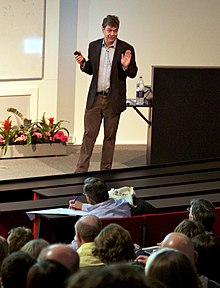Work
White has worked primarily on the formation of structure in the Universe. He is known for his contributions to our understanding of galaxy formation and for his role in helping to establish the viability of the current standard model for the evolution of cosmic structure, the so-called ΛCDM model.
Already at the time of his doctoral work he studied the influence of Dark Matter on the growth of structure and in 1978 he and Martin Rees argued that the properties of galaxies can be understood if they form by gravitationally driven condensation of gas at the centres of extended dark matter halos as these grow steadily in mass through accretion and merging. [5] This has been the basic paradigm for galaxy formation ever since.
In later years White developed computer models which allowed the growth of galaxies and galaxy clustering to be simulated directly in order to allow quantitative comparison of theoretical models with astronomical observations. His 1983 work with Marc Davis and Carlos Frenk demonstrated that the dark matter could not be made of massive neutrinos, at the time the only known elementary particles which were considered possible candidates. [6] Their subsequent work together with George Efstathiou was particularly influential in establishing that a universe dominated by Cold Dark Matter (a new kind of elementary particle of unknown type) could produce large-scale structure in the galaxy distribution which does closely resemble that observed. [7] A more recent large project was the Millennium Simulation, carried out in Garching in 2005 as part of the work of a large international collaboration, the Virgo Consortium. At the time, this was the largest N-body simulation ever carried out, with 10 billion N-body particles representing the dark matter distribution, and using simplified physical recipes to follow the formation and evolution of more than 20,000,000 galaxies throughout a cubic region more than 2 billion light-years on a side. [8]
Work by White has addressed issues of stellar dynamics, of the detailed structure of galaxies and their dark halos, of the processes controlling galaxy formation, of the structure and evolution of galaxy clusters, of the formation of elliptical galaxies through galaxy mergers, and of the statistics of galaxy clustering. Papers include those with Julio Navarro and Carlos Frenk on the "universal" structure of dark matter halos. [9] The Navarro–Frenk–White profile is named after them, and the 1996 and 1997 papers in which they systematically used cosmological N-body simulations to explore its properties are currently White's highest impact theoretical work (with more than 21,000 citations according to Google Scholar). This is because these two papers demonstrated that the characteristic size and density of dark matter halos are tightly related to their mass in a way which depends on, and so can be used to measure, important properties of our universe as a whole, for example, its material content and its spatial curvature, as well as the properties of the initial conditions from which all cosmic structure has grown.
White's more than 500 publications in the refereed professional literature have been cited more than 281,000 times by other scientists (status end-2024 according to Google Scholar).
This page is based on this
Wikipedia article Text is available under the
CC BY-SA 4.0 license; additional terms may apply.
Images, videos and audio are available under their respective licenses.
